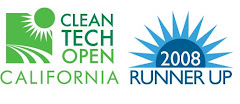 "Drill, baby, Drill"
"Drill, baby, Drill" BY: Todd Woody @ grist
A veteran of the Manhattan Project is developing technology that could make it easier to tap geothermal energy locked deep underground.
[disclosure: GroundSource Geo is affiliated with Potter Drilling]
It’s the archetypal Silicon Valley story: Unknown entrepreneur toils away on a Big Idea in an anonymous office park until discovered by one of the Valley’s legendary deep-pocketed investors.
Another boy wonder CEO hatching the next Twitter or Facebook? Not quite. Meet Bob Potter, 88. He started his hardware company when he was just 83 with technology that grew out of his work on the Manhattan Project (yes, that Manhattan Project) back in the 1940s at Los Alamos National Laboratory in New Mexico.
It’s all about bits, not bytes. Bits as in drill bits. Potter Drilling is developing a deep-drilling technology to tap geothermal heat miles below the earth’s surface—heat that could be used to generate carbon-free electricity.
Conventional geothermal power plants draw upon underground aquifers of hot water relatively close to the surface to create steam that drives electricity-generating turbines. The problem is that underground water currently tapped for geothermal is found mainly in the western United States. But the technology Potter is developing could drill much deeper, meaning geothermal energy could be generated nationwide.
According to a 2006 MIT study, so-called Enhanced Geothermal Systems could potentially supply 2,500 times the country’s current energy consumption. That grabbed Google’s attention, and last August the Internet giant’s philanthropic arm agreed to invest $4 million in Potter Drilling as part of its green energy initiative.
The tech twist: Potter drills not with hard-as-diamonds bits but with water—extremely hot water. (More on that in a bit.) The goal is to radically cut the cost of EGS to spread the technology to regions that rely too much on coal for generating electricity but are not suited for solar, wind and other renewable energy generation.
“It is fun to see some old dreams come true,” says Potter standing in the company’s Redwood City lab-slash-workshop in a light-industrial park wedged in between Interstate 101 and the railroad tracks. He has just pulled into the parking lot after making the 1,200-mile drive up from his home in New Mexico (with a side trip to Fresno to visit his 95-year-old brother).
Tall and le
But Potter soon encountered a major obstacle to making geothermal as common as coal: Drilling as deep as six miles below the earth’s surface is incredibly expensive, presenting a host of obstacles to overcome. Even conventional geothermal developers spend millions of dollars to just drill test wells. But EGS rigs must penetrate miles of hard rock that slows drilling to a crawl. And a broken drill bit 30,000 feet underground can force the abandonment of a $10 million well.
“Getting into the drilling was forced on us in a way because that was thing that really prevented hot fractured rocks from being viable,” says Potter.
When government funding of geothermal research dried up with the crash of oil prices in the early 1980s, Potter moved on to other endeavors. But in the late 1990s he returned to geothermal, and with MIT chemical engineering expert Jefferson Tester patented a drilling technology called hydrothermal spallation. Potter then persuaded his son Jared to start a company in 2004 to commercialize the technology and serve as its CEO.
The younger Potter holds a Ph.D. in geology from Stanford University and had already started two Silicon Valley geological-related companies. Potter Drilling limped along for a few years, unable to interest the Valley’s venture capitalists to fund basic R&D on something that seemed so, well, industrial and old economy.
Then Google came calling on a recommendation from Tester. “If Google hadn’t come along, the company would have died,” says Jared Potter, 56.
What seal






1 comment:
drill baby drill
egs > oil
Post a Comment